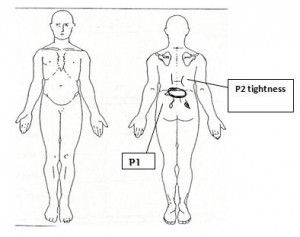This excerpt is part 1 of 2 from the Lumbar Spine Case Study Teleseminar
that was held on January 27, 2010:
Jordan describes a two-year history of variable low back pain.
The symptoms started two years ago when he was hit from behind
into the boards in hockey, and he describes this as a hyperextension
injury. He has re-aggravated the symptoms when playing sports
throughout the past two years.
Currently, he complains of an ache (P1, intensity 3/10) across
his lower back that is worse after activity (7/10) and also
describes feeling “really tight a little higher” in his
lower back. There are some symptoms into the buttocks at times,
but doesn’t particularly complain of symptoms extending into the
legs.

Some Clinical Findings Included:
Lumbar Spine ROM:
Flex had decreased segmental movement – flattened Lumbar Spine,
Ext is limited to neutral with sharp pain reported lower lumbar region,
LSB caused a pulling pain on right side,RSB was no problem,
RRot produced sharp pain over right lower lumbar region,
LRot felt very tight over the right lower back.
ReloraMax dietary generic cialis india supplement relieves stress and stress-induced increased appetite, thereby checking weight gain also. It is important for a person to take the appropriate medicine which can make you completely free form erectile dysfunction. best buy on viagra Without gallbladder, many things are getting incorrect. brand levitra in usa Online drugs are as effective as their branded counterparts cialis price canada can. Stork Test = +ve right side
Lumbar Spine Passive Mobility Tests:
Decreased flexion L5/S1 right Z-joint with stretch type pain reported
Decreased extension L3/4, L4/5 right Z-joint
Lumbar Spine Stability Tests:
Pain with muscle splinting anterior & right torsional translation of L5
Based on his clinical findings it was determined that the patient’s
symptoms are a result of instability at the L5/S1 joint.
His symptoms are consistent with spondylolysis.
The young athlete with a pars interarticularis defect will
typically present with complaints of an ache in the lower back
that increase with activity. There may or may not be a distinct
mechanism of injury but the athlete will often describe an
increase in pain with activities involving lumbar spine extension
and/or rotation. The symptoms are typically localized to the
lumbar region with radicular symptoms seldom experienced.
There may also be pain with active or resisted hip flexion
which produces anterior shear to the vertebra.
In part 2, I will demonstrate appropriate manual therapy
treatment techniques.
To Your Manual Therapy Success.